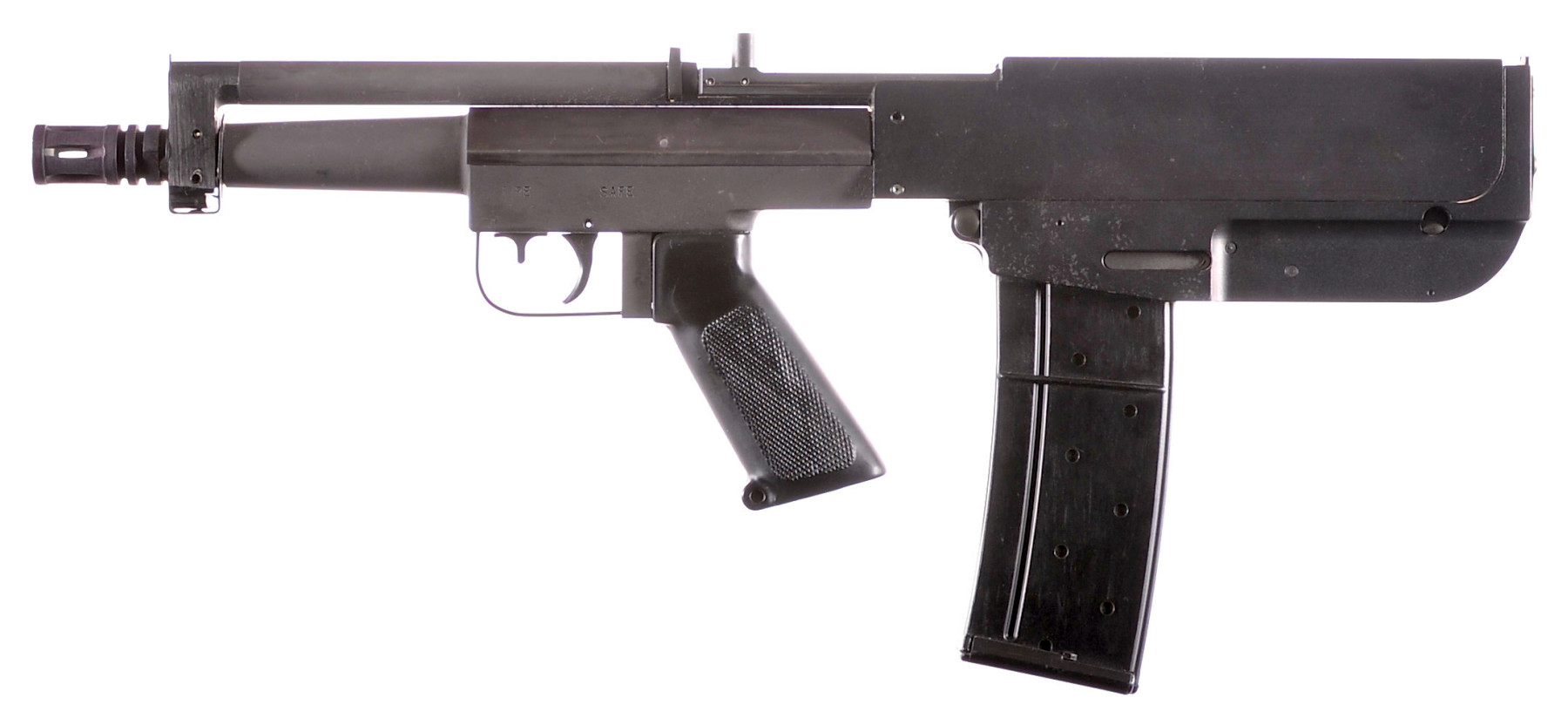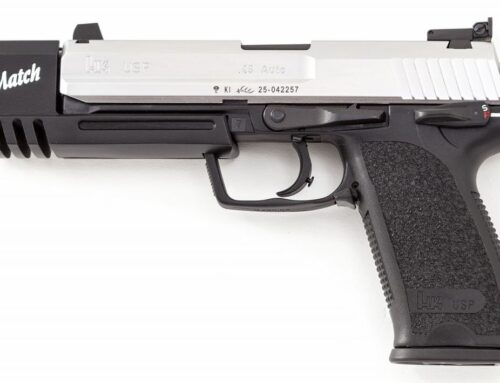Weird and quirky guns are the best. It isn’t because of how great they shoot (which is often questionable) or their ergonomics (which are often terrible) but there’s no denying the strange and unusual stuff draws attention. When dealing with the likes of the incredibly strange, quirky, and awkward “Bushmaster Pistol,” a firearm which I was already passingly familiar with still proved to be the most awkward gun I have ever attempted to shoot. Perhaps there is some method to this madness, though. This is a rare situation where I enjoy writing about a firearm more than shooting it.
The name Bushmaster is nothing new. They’re commonly associated with AR pattern rifles and, if you’re keeping up with more current events, now fall under the Franklin Armory family where hopes are running high they will reintroduce the short lived and problem-riddled ACR rifles. It’s this Arm Pistol thing which has me wondering more about Bushmaster’s origins, though. I’m having to resort to Wikipedia for information on this gun which claims it was made by the Gwinn Firearms Company prior to Bushmaster being acquired by the “Quality Products Company” in 1990. There is mention of a rifle version of this gun which I am not sure of but apparently production of this pistol ran from the 1970’s to 1988. Curiously, the “Bushmaster Pistol” predated Bushmaster as a company. Talk about a strange origin story.
What makes the Arm Pistol so unique is … well, quite a lot. It is classified as a pistol which is technically correct as there is no provision for any sort of stock and it would (still) be quite unwieldy if shouldered. The gun itself utilizes a gas piston system not unlike an AK with an AR-15 rotating bolt.
It feeds 5.56 ammo from STANAG magazines but it’s loaded behind the grip which qualifies the firearm as a bullpup. An 11.5 inch barrel is about centered over the grip but even unloaded the pistol carries most of its weight in the back where thick aluminum pieces make up an upper and lower receiver. Some AR-15 parts can be found here such as the grip, hammer and magazine release.
From here it only gets weird(er).
If you’re wondering why it’s called an Arm Pistol, a label which isn’t present on the gun which is simply called “Bushmaster Pistol,” it’s because the back end is meant to drape across the operator’s forearm. Yes, this four and a quarter pound awkward behemoth is meant to be fired one handed. But wait, there’s more! First picking up an Arm Pistol you may notice a few additional curious details, minor things like “the grip is crooked” and “the charging handle blocks the iron sights,” both of which are very much true. I don’t know what’s up with either of these things but to get any sort of sight picture the upper receiver must first be rotated about 45 degrees clockwise where a super basic V notch has been cut at an angle in the rear sling loop.
You read that correctly.
Not only is everything about the Arm Pistol quirky as all heck but I needed someone to instruct me on how to use it and I was STILL missing an important piece of information. The upper section can rotate either clockwise or counterclockwise where a detent helps to keep it secured …sort of… in position but it only provides any sort of rear sight if you turn it clockwise so the magazine is hanging off to the left.
I had been told by another that this was designed for helicopter pilots to fire LEFT-handed from the side of their helo while flying as a means of discouraging ground forces from firing back upon them. Not necessarily with any intention of hitting targets, mind. More as a means of throwing down some thunder and lightning to try and discourage would-be attackers. On some level I can see how this might work. But why let the top portion be rotated counterclockwise if there aren’t going to be any sights there? Or, crazy thought here, but…why not include sights on BOTH sides?
It gets worse.
These three detents meant to secure the firearm at whatever angle you have it turned to are really not very secure. Not only is it easy to bump it out of alignment but if you go past the outer detents then the trigger no longer resets. You can guess how I figured out this detail. The spent brass ejects straight up away from the magazine so whichever direction the rounds feed from is the direction they will continue their merry journey every time you pull the trigger. I can only wonder if this resulted in hot brass getting sent right back at the chopper pilot if it was held at a less than ideal angle (and to be fair there are zero ideal angles when dealing with this gun.)
There’s also a sheet steel cover between the trigger area and the bottom of the barrel which can easily be slid around by your thumb. Super helpful.
So it’s a near five pound block of awkwardly balanced rifle caliber goodness meant to be fired by an outstretched arm which for most people would also be their non-dominant hand, has a very real risk of disconnecting its own trigger, terrible sights which you may or may not have depending on how it’s rotated, and ejects in a less than ideal direction. How’s it shoot?
As much as I’d like to say “it doesn’t” which is partly true for me given the trigger reset issues, a gentle description would be to call it “awkward” while an honest description would be more like “awful.” First, take the best qualities of even a basic mil-spec AR-15 trigger and throw it out the window along with the spent brass. The pull on one of these is heavy and mushy all the way through. Looking under the hood I could see the long trigger bar hooked up to a particularly flimsy and awkwardly positioned return spring to a small hook on the end. This hook pulls against a small vertical post added to the side of the hammer which releases the sear. This part seems like a simple and straightforward means of turning an AR system into a bullpup configuration but it sure did result in a terrible feeling trigger.
As you can imagine the recoil impulse is abysmal with most of the gun’s weight already placed far behind your grip. If you fire it like I did without draping it across your forearm the grip works as a pivot point and every time you shoot the muzzle will jump a hearty thirty degrees skyward.
From what I can find with a quick image search the safety has had at least three different configurations during the pistol’s life. I believe the earliest version which I was able to test has a small off-set tab within the trigger guard. Pull back for safe, push forward for fire. This control is also awkward to use, though somehow it’s still not as awkward as trying to use the magazine release.
I managed to fumble my way through eight rounds before calling it quits. Between trigger reset issues, failures to feed, and putting up with its overall zaniness, eight rounds was plenty. I can’t even suggest to know what its accuracy might be as I was firing it from the right hand with the receiver rotated the wrong way and thus had no rear sight. At a distance of about twenty feet I was off the mark by at least twelve inches. At least I was fairly consistently off! That poor paper dude’s shoulder wasn’t faring so well by the end.
Finding more information on the Bushmaster Pistol isn’t the easiest but I did come across a fantastic article on Tactical-Life.com written by Will Dabbs, MD only about two years ago and he had some interesting information regarding it. Apparently (and I have no reason to disagree here) the Bushmaster Arm Pistol is the result of something called the IMP-221 which seems to be where the PDW concept had first been born. It predates the big names we’re more familiar with such as the FN P90 and the HK MP7. Sure enough, during the Vietnam War there was interest in providing aircraft crew with survival guns. Colt had been contracted with the task and the “Individual Multi-Purpose Weapon” IMP-221, chambered in .221 Fireball, had been where it all began.
Clearly this concept never made it into service but a former Special Forces soldier named Mack Gwinn, Jr. acquired the rights to the IMP-221 and reconfigured it for civilian use where it shifted to 5.56 NATO.
Dabbs’ article goes into further detail and is a very interesting read if you want to learn more about its origins which can be found at https://www.tactical-life.com/firearms/handguns/bushmaster-arm-pistol/
So, now I have an idea as to the “why” of this gun but it still fails to explain some of its more bizarre characteristics. As to why anyone might want one, there is the historical significance as well as low production numbers. Add in the quirks and you will absolutely get attention at any range. I hadn’t drawn a crowd that big since bringing a .50 caliber Barrett to a deer rifle sight-in. These guns aren’t exactly cheap and they won’t be seeing a lot of use if one is added to the collection but if you really want to confuse your buddies then you can’t go wrong with an Arm Pistol.
Keep an eye on the Range of Richfield’s Gunbroker page and you just might see one popping up for sale soon, too.








